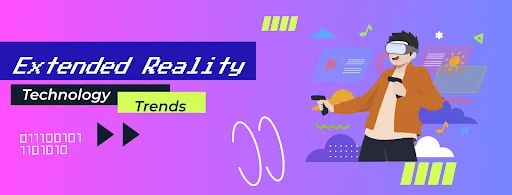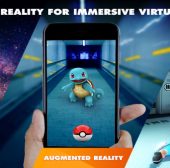The global extended reality market size was exhibited at USD 35.14 billion in 2022 and is projected to hit around USD 345.9 billion by 2030, growing at a CAGR of 33.09% during the forecast period 2022 to 2030.
(Source: PrecedenceResearch)
With changes in time and technology, trends become outdated and new ways loom redefining how we experience things in this exciting world. Extended reality is a new sensation of technology which has its roof on the pillars of AR, VR, and MR. Its integration with other innovations allows it to turn data into memorable experiences. It has changed the means of entertainment, interaction with people and getting our jobs done remotely and securely. The advancements and trends in the most innovative and exciting technologies along with Extended Reality are making sure that interactions are seamless and our experience virtually is as real as possible.
Technology Trends in XR - 2024
Extended Reality is breaking new ground and this blog talks about extended reality technology trends like the Metaverse, Digital Twin Technology and Holoportation. Let's check out technology trends in XR - 2024.
XR and the evolving Metaverse

Metaverse is a series of virtual reality environments that are interconnected and can be accessed by many people at the same time via the internet. This network of 3D virtual worlds connects the virtual and augmented experiences that facilitate movement between interconnected environments. It offers the users control over their digital meta spaces and experiences. The users can readily learn, create, play, connect, communicate, and collaborate with anyone who’s part of the Metaverse, regardless of location or language differences.
The core technologies that a Metaverse Development Company uses include Blockchain, AI and XR and these are continuously enhancing the Metaverse environment through inclusion and decentralization. Numerous Metaverses have been developed that are accessible to anyone who has registered on their platforms. These immersive environments evolve over time as per the user’s demands. Shared virtual environments — real or fictitious, virtual human avatars with realistic speech and body language, and hardware gadgets, accessories, and gears allow people to access the Metaverse and experience the unexpected.
Would you like to know more about XR and Metaverse?
Don't miss: Future of metaverse: How will it transform the workplace
Digital Twin Technology - To Create Lifelike Simulations
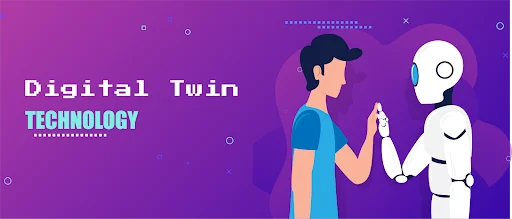
Digital Twin is a technology that helps build replicas of 3-dimensional interactive real-world objects like buildings, cities, trees, vehicles, environments, etc. in the Metaverse. These virtual objects are viewed using XR applications and allow you to explore, visit, admire, and interact with the 3D objects from the comfort of your home.
It is one of the most upcoming technologies of the times whose mechanism depends on collecting relevant data and understanding the physics of the system that will be replicated. The digital twin and the real object are interconnected with sensors that help them gather information enabling us to visually experience how such systems would work before they are built.
For those not in the know, this technology allows you to experiment with different technologies, and create prototypes of products, without any risks involved and spending a lot of money. The game-changing functionality is its capability to reduce a significant amount of waste as it tests solutions before a product’s astronomical development. This influential technology achieves a high level of realism and immersion as it helps create complex environments, interactions, and experiences in the virtual environment.
XR and Holoportation
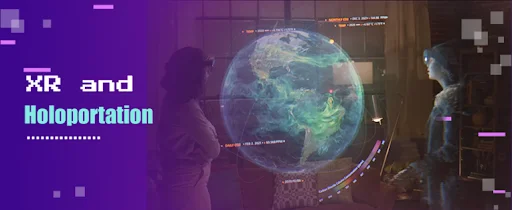
Holoportation is a 3D capture technology that supports virtual mobility. It uses AR and VR to allow game app developers to create high-quality 3D models of people that can be reconstructed, compressed, and transferred in real-time. Mixed reality visual displays like the Holo lens, which is a virtual reality headset, offer an augmented reality experience where the user can view, listen, and interact with other remote participants in 3D. The 3D interaction and communication with clients and colleagues in real-time in the XR space involve specialized cameras with different POVs, making it natural and powerful enough to change the future of work.
Holoportation is making things better for a workplace where an AI workmate or robot can help you translate foreign language, automate recruitment, track time and attendance, provide workforce analysis, and more to improve business productivity. It will work like a tool that will offer you solutions that will make your arduous tasks easier. Such technological advancements are already being leveraged by the manufacturing industry, but their applications, in particular AI Robots, are reaching other industries as well.
Passthrough
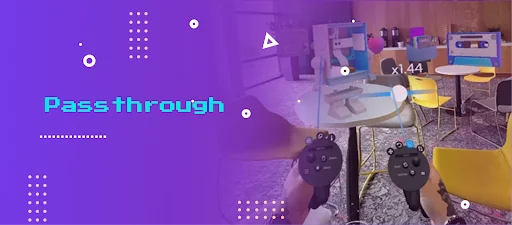
While AR and VR are two very different technologies in the world of immersive technologies their collaboration is opening doors for more opportunities and innovations. One such innovation is the Passthrough which is used to switch in and out of virtual environments by using just a button. Using VR headsets like the Meta Quest headset, creators can use high-definition passthrough technology to explore environments in Augmented Reality in real-time. Front-facing cameras of the Meta Quest 2 allow tracking of the user’s head position and orientation. With Meta releasing a Passthrough API, developers can now integrate the Meta Quest 2 camera into applications and games for a better quality experience.
From the gamers' point of view, Passthrough and wireless headset technology have enhanced the gaming experience by combining AR and VR, allowing the player to move between real and virtual environments comfortably. And when it comes to developers and game designers, Passthrough offers them a development environment that is accessible to all for collaboration, communication, and exchange of ideas.
XR Haptic Technology
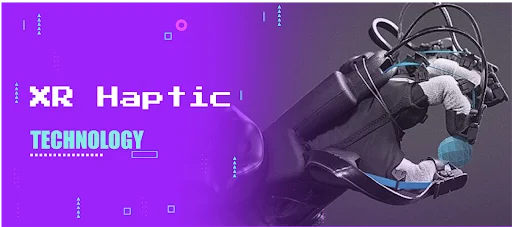
Over the last few years, virtual and mixed-reality gadgets have been used to stimulate the sense of sight and sound in the XR space, but the sense of touch has been neglected. Haptic Technology uses engineering, neuroscience, and a set of mechanical components to stimulate our sense of touch. Haptic makes human and digital interactions feel more real by providing supportive sensations like vibrations, stiffness, pressure, heat, cold, textures, speed, and others with respect to the experience.
The built-in algorithms in the Haptic system work by providing the user feedback and confirming interaction on the touch initiated by them. For instance, there are full-body Haptic suits, Haptic headsets, Haptic touch keyboards, and Haptic wrist controllers that are used for hands-free navigation and interaction in a digital ecosystem. With the interactions being more natural, comfortable, and accurate, chances of error are reduced and users are more satisfied.
In the coming times, Haptic technology will play a major role in the development of Metaverse, robotics, and other immersive technologies. This will improve virtual learning and training, customer experience, user engagement, collaboration, gaming experiences, and so much more.
Extended Reality is breaking new ground, and it is interesting to see the way it has paved paths of innovation. We at Logic Simplified, offer Extended Reality development services that include virtual reality, augmented reality, and mixed reality. Our XR game development company creates immersive & interactive experiences and a new world of possibilities for your business. We are a 12+ years old game design and development company, and have assisted over 100 businesses globally, with our expertise in gaming and emerging technology solutions.
If you would like to know more, get in touch with us at enquiry@logicsimplified.com or call now!
 Get a Quote
Get a Quote

